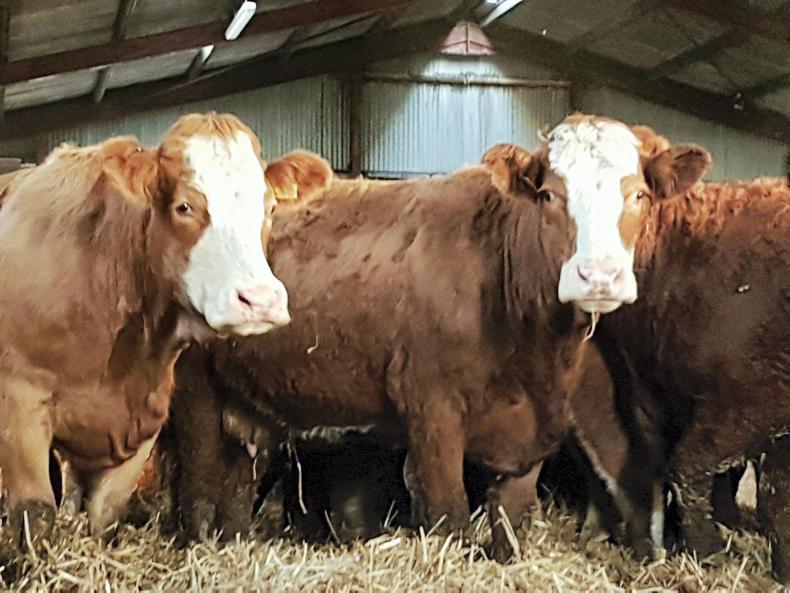As the season has worn on and ground conditions got worse, last week saw us housing the spring cows and calves. As they came in, everything went through the crush and were weighed. They were all treated for worms and the calves had their backs clipped and were vaccinated for pneumonia with Rispoval intra-nasal. The bigger calves are now weaned and, once we finish sorting the stock into their batches, we will get some space made in the pens and get the rest weaned.
We weighed both cows and calves to allow us to calculate weaning percentages and daily liveweight gain. The results of the weighing are in Table 1 below.
We are quite happy with performance and, delving deeper into the numbers, 70% of the calves have done more than 1kg/day daily liveweight gain, with nearly a third of them having done more than 1.2kg/day. The first step in pushing the performance of the herd on will be to look at those with calves doing under 1kg/day and investigate what has caused this. Over time, after running through the usual culling decisions, we will add those cows with slower-growing calves and no excuses to the cull list. By weeding out the poorer end of the herd, the average performance will rise, leading to an improving bottom line.
In Table 2, the weaning percentage has been kept static and the performance of each third is shown in the remaining columns. Looking at these, it can be seen that some of the heavier cows have performed relatively well in relation to their bodyweight, while some of the lighter cows have performed relatively poorly. This demonstrates that the debate is not all about big cows versus small cows. There was a mix of both heavier and lighter cows in both the top and bottom thirds for weaning percentage. What the debate is really about is the output from each cow in relation to how much feed she has eaten for that output. We will also be looking at this data when it comes to culling decisions.
We are also working on tightening the calving pattern this year. The first step in this was taking the bulls out from the cows in the middle of September, giving a defined beginning and end to calving. Looking at the 2017 spring-calving register, only five cows did not calve in the main 12-week period. Yet from the first calf being born in February to the last calf being born in July, spring calving actually lasted for 21 weeks. With more defined bulling dates this year, we will have a more compact calving in the spring, evening up both the batches and the workload.
Autumn calving started in early October and has been working away. We are down to 18 left now but things seemed to have slowed up, with a gap of over a week since the last calf.
With the success that we have had with paddock grazing this year, it has really opened our eyes to the potential output of livestock per hectare that the farm is capable of. Currently we grow around 75 acres of winter barley and 25 acres of spring barley to give us enough straw for bedding and barley for feeding. Sitting on the combine cutting the spring barley late in September, after having finished cutting winter barley a whole month earlier, I really started to question the wisdom of growing spring barley. At the same time, advisers Declan Marren and Robert Gilchrist were looking at the long-term potential that we have here on the farm and, after a discussion around the kitchen table, with some interesting numbers thrown around, we have decided to remove spring barley from the rotation and concentrate on growing only winter barley. We are going to take the area that was down to spring barley and put it in to grass, and this will allow us to further increase ewe numbers.
After the success we had with the paddock grazing this year, we had already decided to increase our ewe numbers this season from 230 to 300. With dropping spring barley next year, we are now looking at really pushing ewe numbers up to 400 and we are also adding more cows to the spring herd, to drive output. This will mean that our current cattle accommodation will be under pressure.
However, we have identified a few small and yet simple improvements we can make to one of the sheds at Mains of Cranna to give us more space. It currently has a centre feed pass and much of the infrastructure from old cubicles. By removing the centre feed pass that currently splits the shed east-west and some walls from the old cubicles, we will have a large flat floorspace. We would then split the shed north-south and remove a blockwork wall to the outside and feed along where the wall was. We would also put in a scrape pass along the feed fence. The suggestion is that by doing this, we should be able to reduce the amount of bedding that shed would require by up to 30%.
Between the expansion in the ewe numbers and replacements, we have purchased a total of 147 gimmers and ewe lambs, with 40 of them being ewe lambs, 32 of them Cheviot mules and the remaining 75 of them Scotch mules. The gimmers and ewes are all with the Texel tup and the ewe lambs are all with the Beltex tup. Tups have been out now for two weeks, meaning lambing should start around the beginning of April.
Growth on this year’s lambs has been a little disappointing, meaning that we have nearly 300 lambs still with us, more than we would have liked. They have been recently moved across from grass on to the neeps to get a finish on them. Looking back on the season, we are wondering if they were perhaps a little short on cobalt after weaning. Pre-weaning, the ewes were receiving cobalt supplementation through tablets in the water troughs.
After weaning, while the tablets were still in the water troughs, the grass was very wet and the lambs were not drinking anywhere near the same amount of water that their mothers had been, meaning they didn’t get the same level of cobalt supplementation as they had been getting pre-weaning.






 This is a subscriber-only article
This is a subscriber-only article














SHARING OPTIONS: